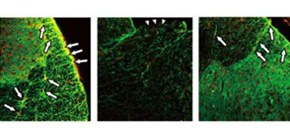
Efficacy of antibody targeting Devic’s disease proven in new animal model
Osaka University study identifies antibody that alleviates symptoms in neuromyelitis optica in rats
Neuromyelitis optica (NMO), also known as Devic’s disease, is a central nervous system disorder that primarily affects the eye nerves (optic neuritis) and the spinal cord (myelitis). It occurs when the body's immune system produces autoantibody in the central nervous system. Autoantibodies are antibodies that target one or more of the individual's own proteins. Most patients with NMO present severe clinical symptoms, such as blindness in one or both eyes, weakness or paralysis in the legs or arms, and painful spasms.
At present, there is no cure for NMO, and no medications have been specifically approved to treat it. This critical gap has motivated a team of researchers from Osaka University to discover new therapeutics against NMO.
“Recently, a role for the protein repulsive guidance molecule-a (RGMa) in the immune system has become apparent. Inhibiting RGMa with its antibody in multiple sclerosis (MS) in rats promotes motor recovery after spinal cord injury and improve disease scores,” explains Kana Harada, lead author of the team’s study recently published in Scientific Reports . “Because NMO and MS are both immune-mediated neurodegenerative diseases with broadly comparable symptoms, we hypothesized that anti-RGMa antibody may have a suppressive effect on NMO.”
The team started off by developing a new rat model that mimics the pathology of intractable NMO by the injection of the antibody NMO-immunoglobulin G (IgG) into the spinal cord. NMO is characterized by the presence of the serum autoantibody NMO-IgG. In contrast to previous animal models of NMO that generally produced disseminated lesions, the new localized model has a single well-demarcated inflammatory lesion, allowing precise investigation of the correlation between the lesion with the deficit in motor function disrupting the corticospinal tract.
“We are excited to find in rats that developed optic neuritis, relaxation of neurological symptoms was observed by suppressing RGMa using humanized monoclonal anti-RGMa antibody antibodies,” corresponding author Yuki Fujita says. “Also, the inhibition of RGMa promotes restoration of injured neural networks, presumably leading to a delay in the progression of the secondary phase of NMO.”
“Our findings support the potential of humanized anti-RGMa antibody as a valid therapeutic approach. We expect this antibody to be further explored as a new therapeutic agent NMO,” co-author Toshihide Yamashita notes.

Fig.1 Inhibition of RGMa ameliorates the severity of NMO model rats

Fig.2. Anti-RGMa mAb partially restored AQP4 and GFAP expression in NMO model rats

Fig.3. RGMa inhibition attenuates neuronal damage in NMO model rats
To learn more about this research, please view the full research report entitled " Inhibition of RGMa alleviates symptoms in a rat model of neuromyelitis optica " at this page of Scientific Reports .
Related links
